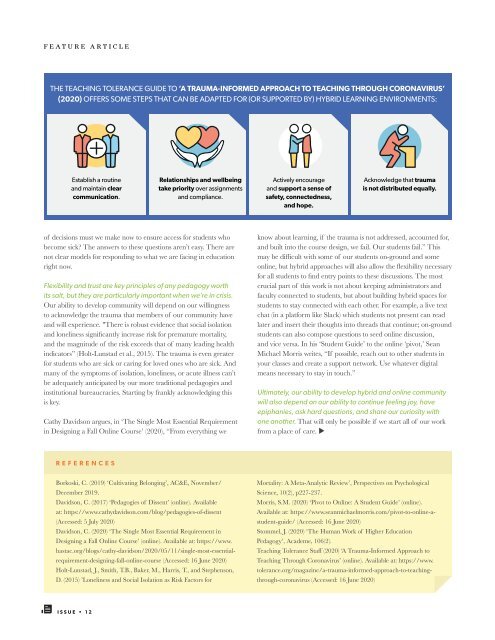The Blue DOT - 12: Reimagining Learning Spaces for Uncertain Times
Create successful ePaper yourself
Turn your PDF publications into a flip-book with our unique Google optimized e-Paper software.
FEATURE ARTICLE<br />
THE TEACHING TOLERANCE GUIDE TO ’A TRAUMA-INFORMED APPROACH TO TEACHING THROUGH CORONAVIRUS’<br />
(2020) OFFERS SOME STEPS THAT CAN BE ADAPTED FOR (OR SUPPORTED BY) HYBRID LEARNING ENVIRONMENTS:<br />
Establish a routine<br />
and maintain clear<br />
communication.<br />
Relationships and wellbeing<br />
take priority over assignments<br />
and compliance.<br />
Actively encourage<br />
and support a sense of<br />
safety, connectedness,<br />
and hope.<br />
Acknowledge that trauma<br />
is not distributed equally.<br />
of decisions must we make now to ensure access <strong>for</strong> students who<br />
become sick? <strong>The</strong> answers to these questions aren’t easy. <strong>The</strong>re are<br />
not clear models <strong>for</strong> responding to what we are facing in education<br />
right now.<br />
Flexibility and trust are key principles of any pedagogy worth<br />
its salt, but they are particularly important when we’re in crisis.<br />
Our ability to develop community will depend on our willingness<br />
to acknowledge the trauma that members of our community have<br />
and will experience. "<strong>The</strong>re is robust evidence that social isolation<br />
<br />
and the magnitude of the risk exceeds that of many leading health<br />
indicators” (Holt-Lunstad et al., 2015). <strong>The</strong> trauma is even greater<br />
<strong>for</strong> students who are sick or caring <strong>for</strong> loved ones who are sick. And<br />
many of the symptoms of isolation, loneliness, or acute illness can’t<br />
be adequately anticipated by our more traditional pedagogies and<br />
institutional bureaucracies. Starting by frankly acknowledging this<br />
is key.<br />
Cathy Davidson argues, in ‘<strong>The</strong> Single Most Essential Requirement<br />
in Designing a Fall Online Course’ (2020), “From everything we<br />
know about learning, if the trauma is not addressed, accounted <strong>for</strong>,<br />
and built into the course design, we fail. Our students fail.” This<br />
<br />
<br />
<br />
crucial part of this work is not about keeping administrators and<br />
faculty connected to students, but about building hybrid spaces <strong>for</strong><br />
students to stay connected with each other. For example, a live text<br />
chat (in a plat<strong>for</strong>m like Slack) which students not present can read<br />
later and insert their thoughts into threads that continue; on-ground<br />
students can also compose questions to seed online discussion,<br />
and vice versa. In his ‘Student Guide’ to the online ‘pivot,’ Sean<br />
Michael Morris writes, “If possible, reach out to other students in<br />
your classes and create a support network. Use whatever digital<br />
means necessary to stay in touch.”<br />
Ultimately, our ability to develop hybrid and online community<br />
will also depend on our ability to continue feeling joy, have<br />
epiphanies, ask hard questions, and share our curiosity with<br />
one another. That will only be possible if we start all of our work<br />
from a place of care. <br />
REFERENCES<br />
Borkoski, C. (2019) ‘Cultivating Belonging’, AC&E, November/<br />
December 2019.<br />
Davidson, C. (2017) ‘Pedagogies of Dissent’ (online). Available<br />
at: https://www.cathydavidson.com/blog/pedagogies-of-dissent<br />
(Accessed: 5 July 2020)<br />
Davidson, C. (2020) ‘<strong>The</strong> Single Most Essential Requirement in<br />
Designing a Fall Online Course’ (online). Available at: https://www.<br />
hastac.org/blogs/cathy-davidson/2020/05/11/single-most-essentialrequirement-designing-fall-online-course<br />
(Accessed: 16 June 2020)<br />
Holt-Lunstad, J., Smith, T.B., Baker, M., Harris, T., and Stephenson,<br />
D. (2015) ’Loneliness and Social Isolation as Risk Factors <strong>for</strong><br />
Mortality: A Meta-Analytic Review’, Perspectives on Psychological<br />
Science, 10(2), p227-237.<br />
Morris, S.M. (2020) ‘Pivot to Online: A Student Guide’ (online).<br />
Available at: https://www.seanmichaelmorris.com/pivot-to-online-astudent-guide/<br />
(Accessed: 16 June 2020)<br />
Stommel, J. (2020) ‘<strong>The</strong> Human Work of Higher Education<br />
Pedagogy’, Academe, 106(2).<br />
<br />
Teaching Through Coronavirus’ (online). Available at: https://www.<br />
tolerance.org/magazine/a-trauma-in<strong>for</strong>med-approach-to-teachingthrough-coronavirus<br />
(Accessed: 16 June 2020)<br />
PANDEMIC COURSE<br />
https://framerspace.com/course/pandemic<br />
ISSUE • <strong>12</strong>


















